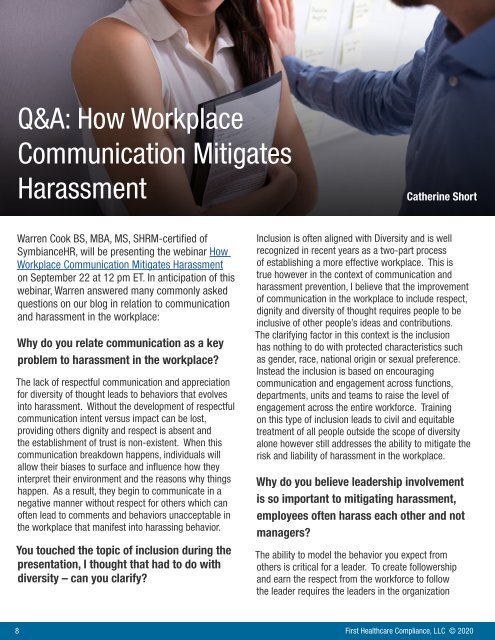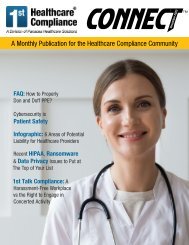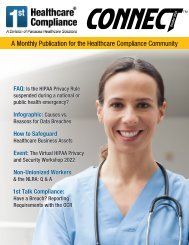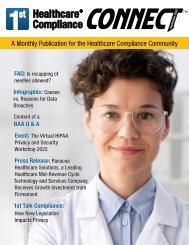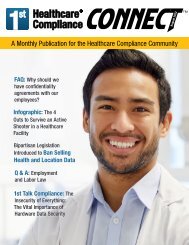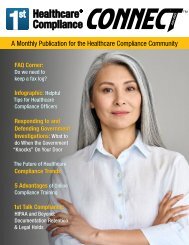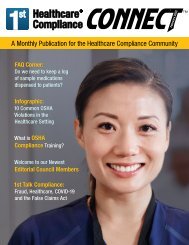First Healthcare Compliance CONNECT September 2020
Create successful ePaper yourself
Turn your PDF publications into a flip-book with our unique Google optimized e-Paper software.
Q&A: How Workplace<br />
Communication Mitigates<br />
Harassment<br />
Catherine Short<br />
Warren Cook BS, MBA, MS, SHRM-certified of<br />
SymbianceHR, will be presenting the webinar How<br />
Workplace Communication Mitigates Harassment<br />
on <strong>September</strong> 22 at 12 pm ET. In anticipation of this<br />
webinar, Warren answered many commonly asked<br />
questions on our blog in relation to communication<br />
and harassment in the workplace:<br />
Why do you relate communication as a key<br />
problem to harassment in the workplace?<br />
The lack of respectful communication and appreciation<br />
for diversity of thought leads to behaviors that evolves<br />
into harassment. Without the development of respectful<br />
communication intent versus impact can be lost,<br />
providing others dignity and respect is absent and<br />
the establishment of trust is non-existent. When this<br />
communication breakdown happens, individuals will<br />
allow their biases to surface and influence how they<br />
interpret their environment and the reasons why things<br />
happen. As a result, they begin to communicate in a<br />
negative manner without respect for others which can<br />
often lead to comments and behaviors unacceptable in<br />
the workplace that manifest into harassing behavior.<br />
You touched the topic of inclusion during the<br />
presentation, I thought that had to do with<br />
diversity – can you clarify?<br />
Inclusion is often aligned with Diversity and is well<br />
recognized in recent years as a two-part process<br />
of establishing a more effective workplace. This is<br />
true however in the context of communication and<br />
harassment prevention, I believe that the improvement<br />
of communication in the workplace to include respect,<br />
dignity and diversity of thought requires people to be<br />
inclusive of other people’s ideas and contributions.<br />
The clarifying factor in this context is the inclusion<br />
has nothing to do with protected characteristics such<br />
as gender, race, national origin or sexual preference.<br />
Instead the inclusion is based on encouraging<br />
communication and engagement across functions,<br />
departments, units and teams to raise the level of<br />
engagement across the entire workforce. Training<br />
on this type of inclusion leads to civil and equitable<br />
treatment of all people outside the scope of diversity<br />
alone however still addresses the ability to mitigate the<br />
risk and liability of harassment in the workplace.<br />
Why do you believe leadership involvement<br />
is so important to mitigating harassment,<br />
employees often harass each other and not<br />
managers?<br />
The ability to model the behavior you expect from<br />
others is critical for a leader. To create followership<br />
and earn the respect from the workforce to follow<br />
the leader requires the leaders in the organization<br />
8<br />
<strong>First</strong> <strong>Healthcare</strong> <strong>Compliance</strong>, LLC © <strong>2020</strong>


